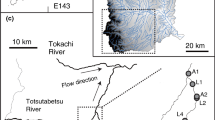Abstract
Larvae of the caddisfly, Diplectrona modesta (Hydropsychidae), were found to be permanent inhabitants of a small, intermittent, headwater stream in southern Ontario. They survived desiccation for at least four weeks in summer. A laboratory experiment gave a mean survivorship of 50% after 30 days without water in stream gravel and stones after the larvae had been permitted to construct their shelters. Survivors were those that constructed their tubes deep in the substrate.
Similar content being viewed by others
References
Clifford, H. F. 1966. The ecology of invertebrates in an intermittent stream. invest. Indiana Lakes Streams 7: 57–98.
Harrison, A. D. 1966. Recolonisation of a Rhodesian stream after drought. Arch. Hydrobiol. 62: 405–421.
Kamler, E. & Riedel, W. 1960. The effect of drought on the fauna, Ephermeroptera, Plecoptera and Trichoptera of a mountain stream. Pol. Arch. Hydrobiol. 8: 87–94.
Author information
Authors and Affiliations
Rights and permissions
About this article
Cite this article
Imhof, J.G.A., Harrison, A.D. Survival of Diplectrona modesta banks (Trichoptera : Hydropsychidae) during short periods of desiccation. Hydrobiologia 77, 61–63 (1981). https://doi.org/10.1007/BF00006388
Received:
Issue Date:
DOI: https://doi.org/10.1007/BF00006388




